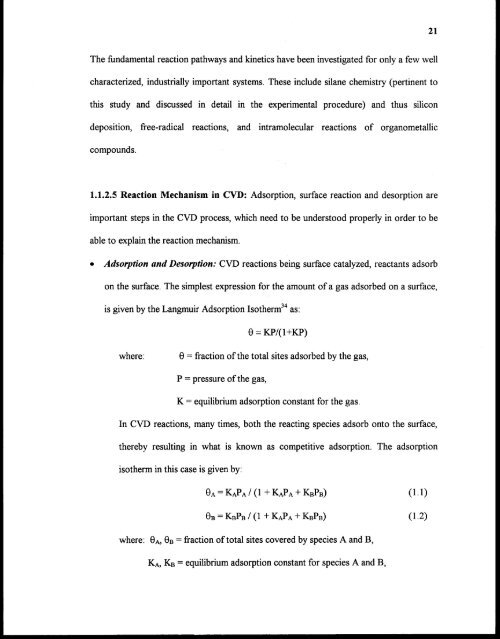njit-etd2000-029 - New Jersey Institute of Technology
njit-etd2000-029 - New Jersey Institute of Technology
njit-etd2000-029 - New Jersey Institute of Technology
Create successful ePaper yourself
Turn your PDF publications into a flip-book with our unique Google optimized e-Paper software.
21<br />
The fundamental reaction pathways and kinetics have been investigated for only a few well<br />
characterized, industrially important systems. These include silane chemistry (pertinent to<br />
this study and discussed in detail in the experimental procedure) and thus silicon<br />
deposition, free-radical reactions, and intramolecular reactions <strong>of</strong> organometallic<br />
compounds.<br />
1.1.2.5 Reaction Mechanism in CVD: Adsorption, surface reaction and desorption are<br />
important steps in the CVD process, which need to be understood properly in order to be<br />
able to explain the reaction mechanism.<br />
• Adsorption and Desorption: CVD reactions being surface catalyzed, reactants adsorb<br />
on the surface. The simplest expression for the amount <strong>of</strong> a gas adsorbed on a surface,<br />
is given by the Langmuir Adsorption Isotherm34 as:<br />
where: 0 = fraction <strong>of</strong> the total sites adsorbed by the gas,<br />
P = pressure <strong>of</strong> the gas,<br />
K = equilibrium adsorption constant for the gas.<br />
In CVD reactions, many times, both the reacting species adsorb onto the surface,<br />
thereby resulting in what is known as competitive adsorption. The adsorption<br />
isotherm in this case is given by:<br />
where: OA, OB = fraction <strong>of</strong> total sites covered by species A and B,<br />
KA, KB = equilibrium adsorption constant for species A and B,
















